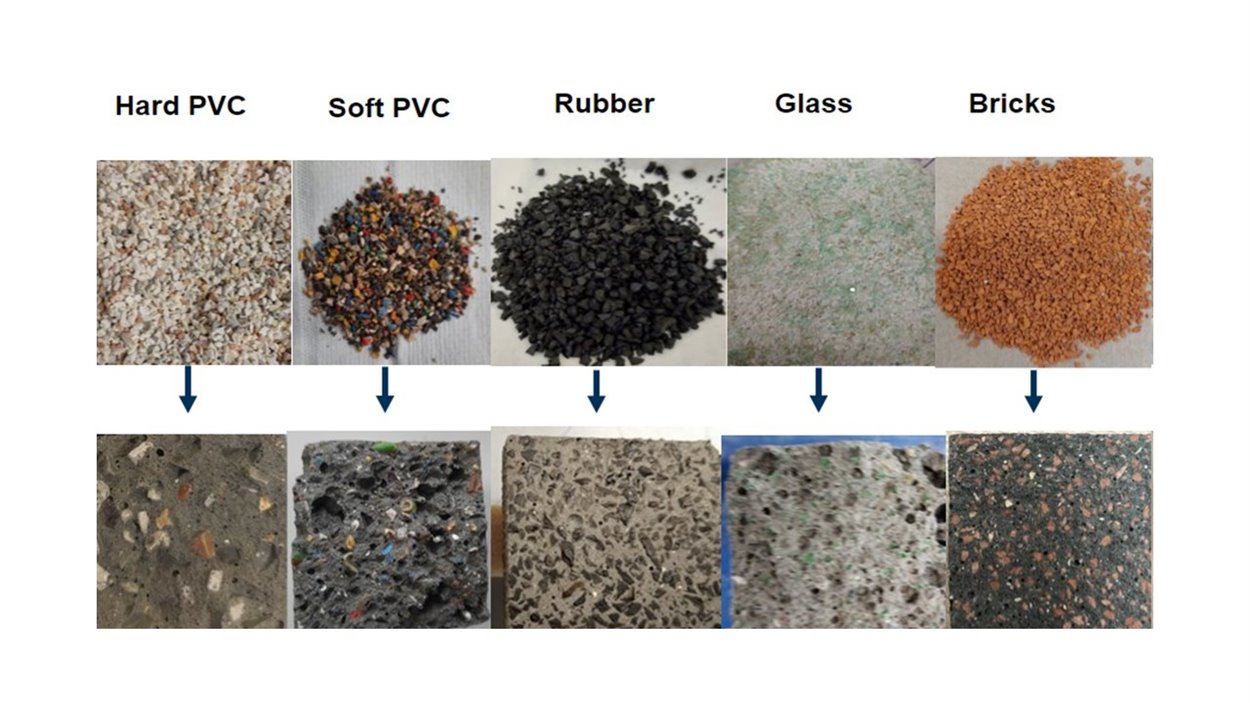Polyvinyl chloride (PVC), an abundantly used plastic, presents significant disposal challenges due to its energy-intensive recycling process, and hazardous leaching when landfilled. Associate Professor Seyed Ghaffar at the UoB Dubai Campus addresses these issues by incorporating recycled PVC into low-carbon concrete, creating sustainable high-quality building materials.
This innovative approach not only reduces PVC's environmental impact but also mitigates the construction industry's substantial carbon footprint. Funded by EPSRC and the European Commission, Seyed's research shows that recycled materials- such as PVC and demolition brick waste- as replacement of natural aggregates enhance concrete properties and outperform traditional concrete, promoting the shift towards a circular economy in construction.
PVC recycling
Polyvinyl chloride (PVC) is a widely used plastic with applications spanning various industries, including healthcare, construction, and food packaging. However, recycling PVC is difficult due to its high chemical resistance, making the process energy-intensive and therefore rarely profitable. If PVC is recycled, it is downcycled into a lower-grade plastic than its previous form. As a result, recycling can only occur a limited number of times before the product reaches the end of its life, often culminating in landfill. PVC’s environmental persistence and slow degradation make it hazardous when it ends up in landfills, as it leaches chloride into the surrounding soil. Therefore, PVC needs to be removed from this unsustainable waste stream.
Dr Ghaffar’s research, addresses this challenge by incorporating recycled PVC alongside other recycled materials as aggregates in low-carbon concrete. His innovative approach transforms PVC into a new, high-quality material, in contrast to traditional recycling systems that degrade the product over time. PVC is shredded rather than melted in Seyed’s research which reduces the energy intensity of the recycling process. Moreover, when recycled PVC is integrated into concrete, it cannot leach into the surrounding environment, significantly mitigating PVC’s long-term environmental impact.
Construction industry
Not only will Seyed’s research combat the broken recycling system of PVC, but it also combats the unsustainable construction industry. Currently, the buildings and construction industry produces over 21% of global greenhouse gas emissions. As urbanization continues, this vital sector faces increased demand. For instance, the UK’s new Labour government has proposed constructing 1.5 million new homes to accommodate the country’s population, necessitating significant input from the construction industry.
A critical environmental concern in construction lies in the production of cementitious composites. Traditional concrete comprises of cement, fine and coarse aggregates, and water. However, conventional cement production (such as Portland cement) is unsustainable as it accounts for 8% of global CO2 emissions. Additionally, the use of virgin materials- like river sand- as aggregates raises resource scarcity concerns and disrupts aquatic ecosystems.
Therefore, new materials must be adopted in the construction industry to enhance sustainability. Some emerging materials have already been created for the industry such as alkali activated materials (AAMs) which are a lower carbon alternative to traditional Portland cement. AAMs are combined with fine and coarse aggregates to create cementitious composites.
The research
Seyed’s research focuses on the aggregates within cementitious composites. Funded by EPSRC within UKRI and the European Commission, Seyed replaced virgin aggregates such as river sand and gravel in with recycled materials to create more sustainable concrete.
Among the materials evaluated were glass, rubber, bricks, polyvinyl chloride (PVC) and unplasticized PVC (uPVC). These materials were sourced from various channels including recycled PVC from electric cable insulation, rubber from tyre waste, and bricks from demolition sites.
Tyre manufacturing poses significant environmental challenges as they release microplastics into the environment via mechanical abrasion on the roads. As 1 billion tyres are produced globally each year the release of microplastics from tyres is significant and therefore minimising tyre rubber waste is crucial for minimising plastic pollution.
Within his research, Seyed incorporates these recycled materials into AAMs and measured the performance of the cementitious composites. Both PVC and uPVC outperformed traditional concrete in thermal resistivity, water absorption, volume permeability voids, high frequency sound insulation and carbon footprint estimation, making them suitable for load-bearing applications. Recycled glass and rubber exhibited comparable properties but were less applicable for heavy load-bearing applications.
 The low carbon concrete products created by Seyed and his team from varying materials.
The low carbon concrete products created by Seyed and his team from varying materials.
Consequently, Seyed has created new sustainable construction materials. He minimises waste using recycled materials to replace virgin aggregates that impose environmental harm, within a material that is currently unsustainable.
Future
Moving forward, Seyed aims to share his research findings with companies and collaborate on projects using his cementitious composites which offer enhanced sustainability and outperform traditional concrete.
However, the construction industry often prioritises profit margins over sustainability due to high initial costs associated with implementing new, sustainable materials. To address this, Seyed emphasises the need for government intervention- in the form of legislation and funding support- to encourage businesses to adopt more sustainable practices and transition towards a circular economy within the construction industry.
Get in touch
If you would like to find out more about this research, please contact s.h.ghaffar@bham.ac.uk (Seyed Ghaffar — University of Birmingham).
Acknowledgement
Seyed would like to acknowledge the team that has supported and worked on this research: Dr Mehdi Chougan, Dr Eslam Elseidy and Yazeed Al-Noaimat.